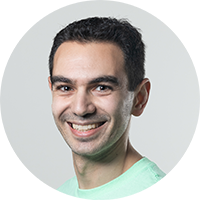Nouveau travail: Project 32
by Joshua Olson-Kerrigan on May 25, 2023

"Make it sound all French and mysterious" — Giant Swarm's HR Manager Josh talks us through our latest organizational evolution.
In September 2022, Giant Swarm decided to move to a 32-hour workweek, better known as the 4-day workweek. After more than half a year, I think it is a good time to sit back and reflect on this shift to see if we have achieved our goals both as a company and as individuals.
Defining Project 32
So first things first, what exactly does the 32-hour workweek mean for Giant Swarm? And why did you call it Project 32 and not just the 4-day workweek like everyone else? Bloody hipsters.
While the majority of us do in fact observe a 4-day workweek, we felt that this didn't provide the flexibility that we wanted. For example, our employees have ~60 children (finding an exact number is hard, okay?) spread between them. Some have opted to take a few hours off every afternoon to spend some more time with their children. Others take two half-days for sports, hiking, side projects, and research.
|
“I decided to reduce my working hours a bit every day, using my P32 time to balance work and personal life, and it has been a game changer for me!” |
|
 |
Carlos Arilla |
|
“I use my P32 time to take care of life admin tasks, and recently I made a beautiful photo book of our family vacation, which we will cherish forever.” |
|
 |
Julia Hahn |
Why Project 32 was the natural next step
Weeeellllllll, nothing new here. Everyone’s heard about the benefits of transitioning to a shorter workweek for mental health and employee satisfaction. We have always championed flexibility in the workplace. See: 100% remote, unlimited vacation, flat org structure… So the shift to a 32-hour workweek really was a natural next step. We want to stay ahead of the curve when it comes to hiring — post-pandemic, 100% remote was no longer so much of a pull. We felt that this was the next big thing.
This is what our VP People, Anna, had to say about why we made the shift:
We believe that P32 is the future of working in our environment. The positive individual effects (like increased mental health and flexibility) more than equal the organizational challenges of implementation in the beginning. A big plus for us was that we have been remote for eight years and know that the time savings due to that should be shared between employer and employee. It is not about more hours or more work. It is about better work. We are no fans of the glorification of being busy.
How has this changed our work lives?
Well, positively, for one. 90% of our employees reported only positive effects from the change. Of the positive effects mentioned, the majority were either better mental health, or increased productivity with fewer distractions when they were actually working. This may have been influenced by our simultaneous shift to more async work and fewer meetings.
Personally, one thing I've really appreciated about Project 32 is that it's encouraged us to think more deeply about how we're spending our time. It's easy to fall into the trap of being "busy" all the time, but Project 32 has encouraged us to be more intentional about our work and how we're spending our time. This has led to a greater sense of purpose and fulfilment in my work.
|
“I use my P32 time to hit the gym and get away from my screen! It’s the perfect opportunity to focus on my health and fitness goals.” |
|
 |
Puja Abbassi |
|
“During my P32 time, I study for my master’s degree and also play video games to unwind. It’s a great way to recharge my batteries and stay motivated for my studies.” |
|
 |
Dominik Kress |
What did we learn?
Longer weekends are better. :P
No, but really. We did some surveys after the fact, and six months later, almost ¾ of our employees said that they were truly living P32. More than half spent less than two hours of personal time implementing P32 for themselves. This would include things such as rescheduling (or canceling) recurring meetings, setting up OOO calendar events, etc.
We also asked individuals to rate their team’s output quality and quantity since moving to P32. We found that quality had improved for more people than quantity, as could be expected. But the majority in both cases said that both quality and quantity remained the same.
Of the difficulties with transitioning to a 32-hour workweek, most people found that shifting to async work and scheduling meetings were the biggest issues. We also asked what would be most useful in helping with the shift to P32. The top answers were better documentation, fewer meetings, and improving our use of GitHub across the company.
We have always tried to foster a culture of autonomy and self-management within Giant Swarm, with people enabled to make decisions as much as possible without oversight or unnecessary bureaucracy. This definitely made the switch easier, as for the most part, each team just had to find consensus on things such as making sure that someone is always available so that no team has a day where they are uncontactable.
Half a year in, things are looking good! (✿◕‿◕✿) Let's touch base again after a year and see if anything has changed.
You May Also Like
These Related Stories

Cloud native predictions for 2024
Hard to fathom we’re already a month into 2024! With the new year comes speculation about what’s on the horizon. Peeking around the corner at what’s n …

Taking Care Remotely
Wellbeing and mental health are current topics inside Giant Swarm, as well as in the larger community. Given that, this is still a delicate and tough …

New Joiners Series: Welcome Georgiana
Welcome to Giant Swarm's New Joiners Series where we get to know some of the newest members of the Swarm. This week, we meet Georgiana Patru.